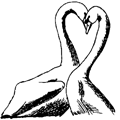Papers in the Biological Sciences

Handbook of Waterfowl Behavior by Paul A. Johnsgard
Date of this Version
January 1965
Document Type
Book Chapter
Abstract
I consider the three species of steamer ducks of the genus Tachyeres to constitute a separate tribe. These authorities agree that although steamer ducks are perhaps most closely related to the true shelducks, the steamers are sufficiently different to warrant removing them from the shelduck tribe. Their downy young lack the strongly contrasting coloration typical of shelducks, and the adult plumage pattern is distinct both from that of the shelducks and from that of the other anatine groups. There is a slight sexual dimorphism in bill color, head color, and possibly in the degree of tail-feather curling. Pair bonds appear to be strong, and Murphy (1936) was of the opinion that steamer ducks pair for life. At least two years are required for the birds to reach maturity. There are apparently three similar-appearing species, of which two are virtually flightless. The voices of the sexes are very different, and the males have tracheae with rounded, osseous bullae which are similar to those of Anas. There is no metallic coloration in either sex; the wings have white secondaries and secondary coverts. All species dive extremely well, and the birds feed to a great extent on marine animal life off coastal South America and the Falkland Islands.


Comments
From Handbook of Waterfowl Behavior by Paul A. Johnsgard. Copyright © 1965 Cornell University Press; electronic edition copyright © 2008 Paul A. Johnsgard.